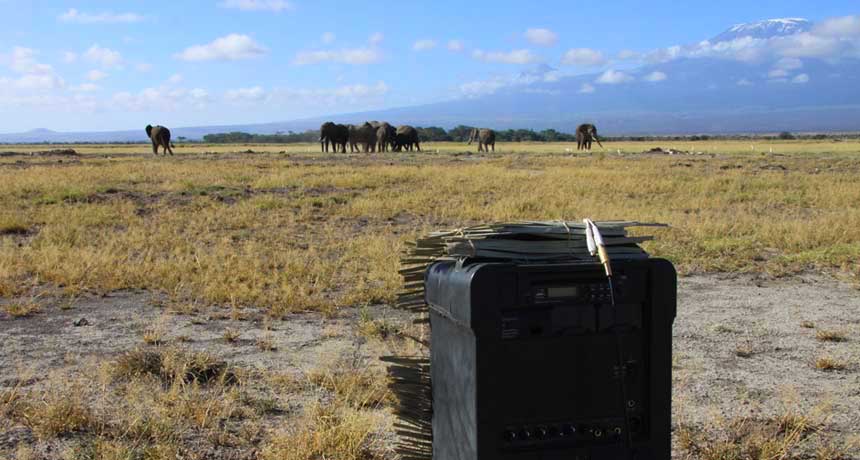
THE VOICE A study of how elephants respond to human voices broadcast from a portable speaker suggests that Amboseli National Park’s elephants can tell a lot about a person just from how he or she talks.
Courtesy of G. Shannon
Elephants may pick up on differences between the voices of men and women, and even between the speech sounds of two African ethnic groups.
In tests in Amboseli National Park in Kenya, recordings of men’s voices, or of Maasai voices versus those of another ethnic group, were especially likely to prompt a bit of defensive behavior among family groups of elephants. Animals tended to edge closer together and change their travel direction, report Karen McComb of the University of Sussex in Brighton, England, and her colleagues.
Playing recorded human voices to elephants “was a way of getting at whether they could pick up very subtle vocal cues to pick out which were the most dangerous situations, when faced with a really versatile predator,” she says.
That versatile threat, which comes in many forms, is of course humans. “Apart from lions, they’re the main predator elephants have to worry about,” McComb says. Earlier, she and her colleagues showed that older and more experienced elephant matriarchs differentiated between recorded roars of female and male lions, the latter of which pose the greater danger (SN: 4/9/11, p. 10). Elephants encounter plenty of people in the park, but for a long time, the ones most likely to kill elephants have been Maasai men. That gender and ethnicity were the most likely to trigger defensive behavior in the elephants, the researchers report March 10 in the Proceedings of the National Academy of Sciences.
Maasai herd livestock throughout the region and retain the right to bring their animals into the park for water. Elephants also travel widely, moving in and out of the park with plenty of opportunity for conflict. Until recently, an elephant killing Maasai people or their livestock often resulted in men hunting down elephants. Relations have grown more harmonious since the government has made more effort to compensate for elephant-killed livestock and to share park revenues so Maasai benefit from the elephants, McComb says. Still, she says, the elephants still remember.
In contrast, the Kamba people, whose voices didn’t stir as much of a reaction from the elephants, farm on settled plots in a smaller swath of elephant territory. They clash infrequently, mostly with the occasional elephant that develops a taste for crop raiding.
To record the 35 voices for the test, researchers asked Maasai and Kamba volunteers to say in their own language, “Look, look over there. A group of elephants is coming.” Volunteers were asked to speak without urgency but rather loudly, as if to someone 20 or 30 feet away. In overall sound, the two languages differ about as much as English and Spanish do, says coauthor Graeme Shannon of Colorado State University in Fort Collins who understands neither African language.
It took two field seasons to play the recordings for 47 elephant family groups. Researchers watched for such behaviors as raising trunks to sniff, extending ears or bunching together. The team then scored the intensity of the huddling reaction. The more disturbing voices (male or Maasai) averaged above 1 on the scale (subtle reduction in diameter of the group) but did not reach 2 (interruption of activity and formation of a coordinated bunch within three minutes). The less threatening voices (female, boy or Kamba) ranked below 1.
To a person, distinguishing voices might seem trivial — just pick the deeper voice. But elephants are probably using other cues such as breathiness, McComb says. Digitally raising the pitch of recorded male voices and lowering the female ones to swap gender did not fool the elephants at all.
The idea that elephants with long experience of human contact would distinguish the voices most likely to be dangerous sounds perfectly plausible to Anne Clark of Binghamton University in New York. She studies urban crows, which can learn a lot about signs of danger or food windfalls from people.
LOOK OVER THERE Elephants react to hearing a recording twice of a Maasai man saying in his language, “Look, look over there. A group of elephants is coming.” The video sound is an example of what was played for the elephants but is not the exact clip these elephants heard. Courtesy of G. Shannon





